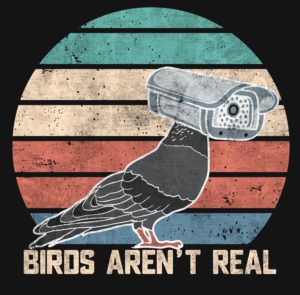
Birds Aren’t Real. And Neither Is MLOps

(Butusova-Elena/Shutterstock)
Are birds real? A group of 20-somethings tried to convince us they weren’t in the past few years, to varying degrees of success. And now a University of Washington professor wants us to believe that MLOps isn’t real, either. What is the world coming to?
“MLOps is NOT real,” Luis Ceze, a professor in the UW computer science and engineering department, declared in a statement. Ceze is also the CEO and co-founder of OctoML, the Seattle, Washington company that is commercializing Apache TVM, the open source tool for automating the deployment of machine learning models to a variety of platforms, including those running atop GPUs, CPUs, FPGAs, and other types of processors.
As one of the creators of Apache TVM, Ceze is imminently familiar with what the world means by “MLOps,” which most of us believe refers to the tools and techniques that data scientists, software engineers, and other IT professionals use to deploy and maintain machine learning models in production.
So what is the deal? MLOps is clearly a thing. Is Ceze some kind of conspiracist or something?
“I promise you that the Earth is not flat,” Ceze told Datanami, alleviating one of our concerns. “I promise, I’m not trying to be contrary just to get attention.”
After explaining what he meant, it turns out Ceze is not playing an early April Fool’s joke on an unsuspecting tech reporter after all. The professor has given his provocative statement on the existence of MLOps quite a bit of thought. He has his (very real) ducks in a row.

Luis Ceze is a professor of computer science at the University of Washington and the CEO and co-founder of OctoML
The gist of Ceze’s argument that MLOps isn’t real comes down to this:
While the creation of machine learning models requires special skills and tools, once the models are created, there is no good reason that they should be treated differently than any other piece of code. The state of the art for maintaining and deploying arbitrary code today is a practice known as DevOps, and since DevOps is sufficient for maintaining and deploying machine learning models, that means MLOps is an extraneous idea that brings additional complexity and, therefore, shouldn’t exist.
“MLOps is not a huge thing yet,” Ceze said, acknowledging that MLOps does exist, just like birds. “I’m just saying this thing that we’re starting to give a name to…we shouldn’t be giving a name that has the same meaning of what people call DevOps.”
Instead of building or buying a new MLOps tool to manage the maintenance and deployment of machine learning models, Ceze says data-driven organizations should instead be looking to leverage their existing DevOps investments to do that.
While he grudgingly acknowledges the existence of MLOps, it is clear that Ceze does not like the new product category one bit, and that he thinks the world would be a better place without it.
“Why should we treat a machine learning model as if it were a special beast compared to any software module?” Ceze says. “It just feels like there’s a huge complexity we’re adding to this, and it’s not addressing the fundamental question of, Why do you have to treat them differently after the model is created?”

The New York Times declared the “Birds Aren’t Real” campaign to be a “Gen-Z conspiracy”
Ceze acknowledges that the initial creation of the machine learning models is a special beast unto its own. Created by a unique breed of unicorns called data scientists, there is a lot of art and skill that goes into creating models that have the right properties, the right accuracy, and the right explainability, Ceze says.
“This is all important, this is all special, and we are creating very good tools for that,” Ceze says. “But if you’re talking about MLOps as how do you deploy and integrate models into your application? I just think…to get it really right, you should be able to use your existing DevOps infrastructure and your existing DevOps people to do it.”
One definition of a machine learning model is code plus data. So in that respect, a model doesn’t contain just “code.” But lots of traditional (i.e. deterministic) applications also contain bits of data like that, Ceze says, and nobody has created entire product categories out of whole cloth to manage them. So why do it for machine learning?
“The way people do MLOps today is with a bunch of custom scripts that people just glued together with bubblegum and shoestring,” Ceze says. “There are a lot of platforms that people are calling part of MLOps that are basically requiring users to go and write a bunch of scripts into their platform and do more work than should be required.”
Machine learning engineers have enough challenges to overcome when trying to deploy a machine learning model without adding another layer of complexity via MLOps, Ceze says. The machine learning world should be moving towards more simplicity, and re-using well-understood tools and techniques where it can, rather than adding additional layers of complexity into a field that is already rife with it.
“There’s something that we’ve been calling the ‘Matrix from Hell,’ which is we have models, we have frameworks, and we have hardware, and then to actually turn a model into something that it can be applied as a module in your application, you have to navigate a lot of hardware-vendor specific tooling, you have to navigate a lot of framework-specific tuning,” Ceze says, referring to the traditional MLOps workflow. “And what you’re getting is still something that requires quite a bit of manual work for you to go and integrate with your application.”
There is a role for Apache TVM, which started as a research project in Ceze’s group at the University of Washington, to play in the simplification of machine learning. The software serves as an abstraction layer that eliminates much of the technical complexity typically involved when taking a model developed in machine learning framework like TensorFlow, PyTorch, Keras, MXnet, Core ML, or ONNX and getting it to run on Intel X86 chips, AMD CPUs, Nvidia GPUs, Arm processors and MMUs, Qualcomm SoCs, and FPGAs.
“We bring a lot of simplicity in turning models into things that deploy on the hardware you want, without having to worry about the details of the hardware,” Ceze says. “Data scientists shouldn’t have to worry about what tools should they use. In fact, if we did it right, they shouldn’t even care whether they’re using TVM or not. What they care is that we’re producing a module that they can just go and deploy.”
Obviously, MLOps is real, just like birds. And just as the Birds Aren’t Real folks succeeded in making a larger point about the nature of misinformation in the age of instant communication, Ceze also has a larger point: just because MLOps is real, it doesn’t mean you have to use it–especially if you already have an established DevOps practice in your shop.
Related Items:
MLOps Pays Dividends for New York Life



























